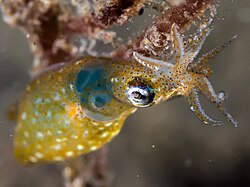Biology:Idiosepiidae
| Idiosepiidae | |
|---|---|

| |
| Idiosepius pygmaeus | |
| Scientific classification | |
| Domain: | Eukaryota |
| Kingdom: | Animalia |
| Phylum: | Mollusca |
| Class: | Cephalopoda |
| Superorder: | Decapodiformes |
| Order: | Idiosepida |
| Superfamily: | Idiosepioidea Appellöf, 1898 |
| Family: | Idiosepiidae Appellöf, 1898[1] |
Idiosepiidae, also known as the pygmy squids, is a family of squids in the superorder Decapodiformes.[2][3] They are the smallest known squids.[3]
It is the only family in the monotypic order Idiosepida[4] and the monotypic superfamily Idiosepioidea.[5] Phylogenomic analyses have shown that species in the family Idiosepiidae are sister to all other Decapodiformes.[6]
Description
Idiosepiidae are the smallest known squids: males can grow to about 15 mm (0.6 in) and females to about 21 mm (0.8 in) in mantle length. The mantle is elongate, obovate to cigar-shaped, with its posterior margin bluntly pointed at the distal tip. The head is prominent while the arms are short. In males, both ventral arms are differentiated, but they are also different from each other.[3]
Distribution and ecology
Idiosepiidae have an Indo-west Pacific distribution, from South Africa in the west to Japan and Russia in the east. They appear to be short-lived. They generally live in shallow water among seagrass and mangroves. They often adhere themselves to substrate, enabling camouflage and concealment during the day. They appear to be sit-and-wait predators. They are solitary. Mating is promiscuous with multiple matings. Young individuals are planktonic.[3]
Genera
The following genera are recognised in the family Idiosepiidae:[2]
- Idiosepius Steenstrup, 1881
- Xipholeptos Reid & Strugnell, 2018
References
- ↑ Appellöf, A. (1898). "Cephalopoden von Ternate. 2. Untersuchungen über Idiosepius, Sepiadarium und verwandte Formen. Ein Beitrag zur Beleuchtung der Heklokotylisation und ihrer systematischen Bedeutung". Abhandlungen der Senckenbergischen Naturforschenden Gesellschaft 24 (4): 570–637. https://www.biodiversitylibrary.org/item/54935#page/600/mode/1up.
- ↑ 2.0 2.1 "Idiosepiidae Appellöf, 1898". MolluscaBase. World Register of Marine Species. http://www.marinespecies.org/aphia.php?p=taxdetails&id=153037.
- ↑ 3.0 3.1 3.2 3.3 Reid, Amanda L.; Strugnell, Jan M. (2018). "A new pygmy squid, Idiosepius hallami n. sp. (Cephalopoda: Idiosepiidae) from eastern Australia and elevation of the southern endemic 'notoides' clade to a new genus, Xipholeptos n. gen.". Zootaxa 4369 (4): 451486. doi:10.11646/zootaxa.4369.4.1. PMID 29689867.
- ↑ "Idiosepida". MolluscaBase. World Register of Marine Species. http://www.marinespecies.org/aphia.php?p=taxdetails&id=1454586.
- ↑ "Idiosepioidea Appellöf, 1898". MolluscaBase. World Register of Marine Species. http://www.marinespecies.org/aphia.php?p=taxdetails&id=1454587.
- ↑ Anderson, Frank E.; Lindgren, Annie R. (2021-03-01). "Phylogenomic analyses recover a clade of large-bodied decapodiform cephalopods". Molecular Phylogenetics and Evolution 156: 107038. doi:10.1016/j.ympev.2020.107038. ISSN 1055-7903. https://www.sciencedirect.com/science/article/pii/S1055790320303109.
Wikidata ☰ Q2196443 entry
 |

